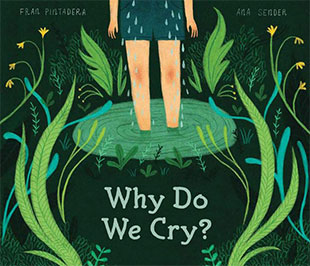Tears can be shy, reluctant to emerge. So author Fran Pintadera wisely begins this story with a boy named Mario, who takes his time after a quiet morning to ask his mother the title question. This gently paced third-person perspective allows children who hear the story to reflect on the "why" of tears without having to think about their own feelings directly until they are ready.
By the second page, Pintadera and illustrator Ana Sender take this therapy one step closer, as the mother thinks about the question from her own experience and answers, "We cry for a lot of reasons, Mario. Sometimes we cry because the sadness we feel is so great that we just can't contain it." We see a silhouette of the mother as a girl, kneeling and crying. From her long, braided ponytail emerge black birds that fly away.
Each new page spread is full of astute imagery. When the mother acknowledges anger as a reason for crying, she becomes a cloud with rain cascading down by the force of her feelings. When she mentions how tears help us grow, the streams of tears from her eyes turn into flowering vines that support colorful and adorable wildlife. When she cries because she hurts, she is able to float in the pool of her own tears, a calm expression on her face, and we read that "tears are the best medicine."
But the most extraordinary part of this book is its subtle but substantial approach to abuse. We learn that sometimes people cry because "shouting for hours doesn't help." And on the next page, even though the mother-as-a-girl has her feelings literally under lock and key, in a box on her lap, they escape anyway, lapping around her feet as she looks at a family portrait ... of a wolf! We cannot think of a better way to illustrate how abuse feels from the inside.
The two closing images show the potential for clarity to come from crying and with happy tears. Then we are treated to some helpful facts tailored for 3 - 7 years olds: about the different kinds of tears, what they're made of, why they're good for us, and more. And finally, two suggested activities bring the book's message back to readers, allowing them to ponder their own reasons for tears more deeply.
